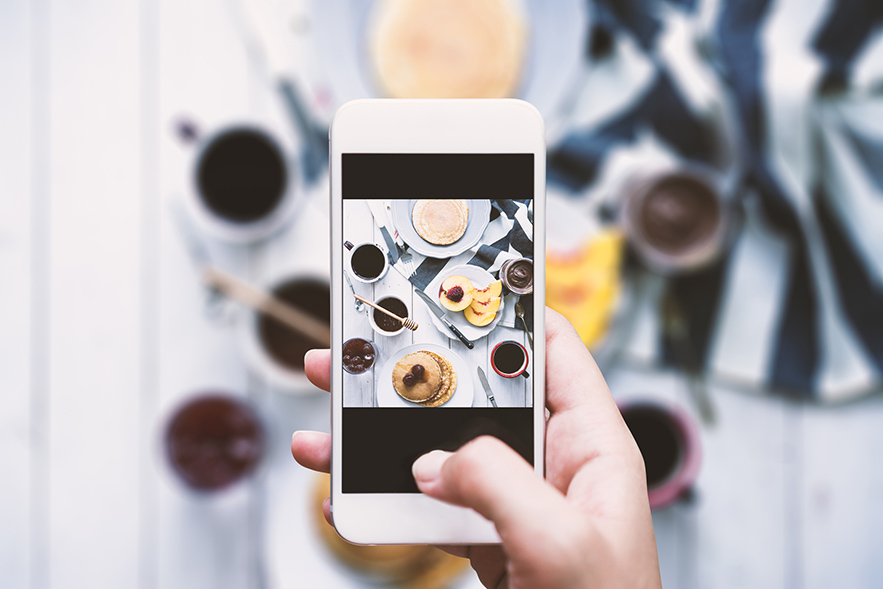Prior to the advent of social media, marketing for chefs and restaurateurs included constantly working to attract journalists to dine in their restaurants, hosting events for hotel concierges to help with word of mouth and coveting good reviews from critics. The world of culinary marketing was forever changed in 2010 when Instagram launched. It’s true that Facebook and Twitter were vehicles of communication, but the popularity of posting food photos caused a seismic shift in restaurant social media — one that has a direct impact on the bottom line.
“Instagram is a particularly unique platform,” explained David Spiegelman, vice president and creative director at PR and marketing firm Wagstaff Worldwide, during a social media seminar at ICE’s Los Angeles campus. “Without media or a budget for PR, without a story that’s compelling for a journalist to come and write about you, or if you’ve been around a long time and don’t have constant stories to tell, social media becomes your way to tell your story directly.”
The first thing a food business needs to do is locate the target audience online. “Every restaurant has a different demographic that includes age or location,” David said. “Figure out where those people are spending their time online as different platforms reach a different audience.” While Facebook traditionally skews older, David explained more of that demo is becoming active on Instagram. That doesn’t mean it’s time to suspend your Facebook account.
“Facebook becomes a website alternative where you can have all this data — location information, hours, detailed explanations, reviews, all the things you can’t do on Instagram,” he said. In addition, Facebook owns Instagram and having a Facebook account is an important piece of the equation for geo-tagging. However, in terms of content, Instagram is in vogue for restaurant marketing. “It’s where we put most of our energy when we are working with our clients,” David said of his marketing agency. “More often people are going to Instagram to make dining decisions, and it’s their first point of contact with brands.”
Why not Twitter? “Culinary is visual,” he continued. “It’s amazing how many restaurants we look at that don’t properly articulate who they are on Instagram or what their food is like, and it’s a big miss.”
Here are David’s essential tips for maximizing return on the powerful medium.
Take Better Photos
“The best advice I can give anyone right now is to develop your photography skills,” he said. “Whether a chef or getting into the restaurant space, there’s nothing that can benefit you more than being able to take and edit photos for your social channels.” If you’re thinking that you need help getting your photos in tip-top shape, David recommends YouTube videos as an educational resource “when you are thinking about making yourself equipped for the culinary space right now.”
See upcoming food photography classes at ICE.
Define Your Point of View
“Figure out who you are,” David advised. Define your business’ story and ethos, and don’t feel like you’re locked in to one narrative because, as David reminded students, that story can change and shift.

Be Personal
“Be comfortable telling your personal stories and connecting with your audience,” he said. Give your audience a look behind-the-scenes, talk about challenges you face — people respond to authenticity. An example David referenced was Chef Dominque Crenn, who recently shared her cancer diagnosis with her Instagram audience. “People are really engaging with her and they care about her and feel like they are part of that process,” he explained. “When people effectively use social, especially chefs, it’s really personal. It’s not about oversharing, but making sure you’re not scared to do that.”
Take Risks
“Show weird stuff,” David suggested. “For a long time, April Bloomfield did a good job of that. She would show baby pigs in a pen and the next post would be a pig’s head boiling on the stove.” Though it might seem a bit crazy, David recommended taking that kind of risk. “People might not like your photos, but whatever,” he said. “If the quality of the photo is good, you can take more risks.”
Post Consistently
Post regularly, though that doesn’t mean you need to post every day. David recommended posting no more than four to five times a week. “A lot of people seem to think they need to post two to three times a day, or you’ll read blogs talking about ‘posting cadence’ and the more content the better,” he said. “Don’t put that pressure on yourself at all.” The great news is, people don’t unfollow you because they don’t see content from your handle. “If you don’t have anything good for the next week and a half, don’t post,” he advised. “Make sure what you’re posting is compelling, has a POV and really tells your story. If it doesn’t, don’t publish it.”
Invest in Instagram Stories
“People are spending more time on Stories right now,” David said. “That’s just going to continue to grow, so make sure it’s part of your strategy.”
Mind the Grid
According to David, 90-95% of the people who come to your Instagram page may never return, but the people who are coming are new people who likely don’t know anything about your brand. “Users will see those first nine images [on your profile feed] so it’s really important to keep those that will really engage an audience,” he said.
Convert to a Business Profile
There are two kinds of Instagram profiles: personal and business. “Instagram has opened up analytics on their platform for business profiles, so you no longer need a third-party app to track,” he explained. “Even if you are a culinary student who’s going to become a chef, do that so you can have access to analytics” to measure your audience’s interest and plan better engagement.
Learn more about developing a marketing strategy in Restaurant & Culinary Management.




